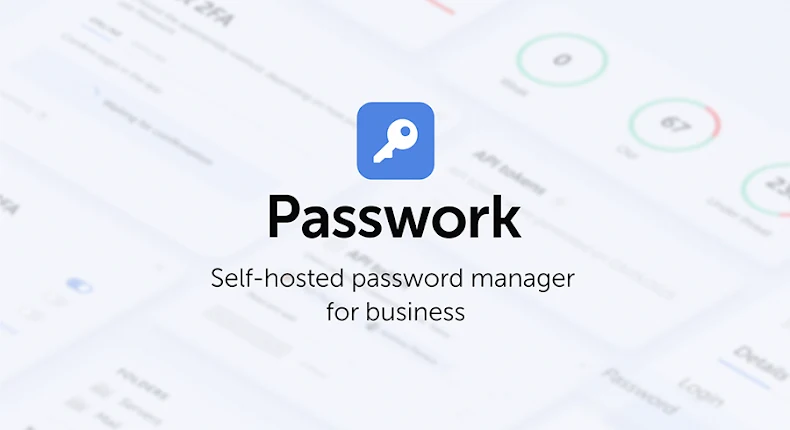
Passwork is positioned as an on-premises unified platform for both password and secrets management, aiming to address the increasing complexity of credential storage and sharing in modern organizations. The platform recently received a major update that reworks all the core mechanics.
Passwork 7 introduces significant changes to how credentials are organized, accessed, and managed, reflecting feedback from real-world users. The redesign prioritizes usability and security, with a focus on streamlining workflows and making key features more accessible.
Passwork isn’t trying to reinvent the wheel. Instead, it focuses on solving a very real problem: how do businesses keep credentials organized, secure, and accessible without adding complexity or risk? In this article, we’ll look at what Passwork 7 delivers, how it fits into a business environment, and what makes it different. Below is a walkthrough of its main features and workflows.
Getting started: User experience and onboarding
The first thing you notice with Passwork 7 is its new interface that immediately signals its focus on simplicity. The dashboard provides a clear overview of vaults, folders, passwords, and recent activity. The idea is simple: streamline onboarding and avoid distracting users from their core tasks.
This approach is especially important in sectors like public service, education, and healthcare, where staff often have limited time or technical expertise. By reducing the learning curve, Passwork helps organizations roll out secure password management quickly and efficiently, without disrupting daily operations or requiring extensive user education.
Search and filtering options are simple, ensuring users can locate the right password without unnecessary complexity.
Vaults, folders, and password
Passwork 7 uses a hierarchical structure for organizing data:
Vaults are the main containers for credentials
Folders help organize related passwords within a vault
Password cards store individual credentials, including username, password, URL, notes, 2FA codes, and attachments
To add a new password, users select the appropriate vault, create a folder (if needed), and fill out a password card with the required details.
The system is flexible: organizations can build a structure or hierarchy of vaults and folders to reflect their internal company layout and security requirements. This approach allows businesses to align credential management with their own processes, whether that means mirroring a strict departmental separation or supporting cross-functional teams.
Vault types: Data segmentation
Solution introduces a flexible vault architecture designed to improve security and management. Administrators can define custom vault types that align with an organization’s structure, making it easier to control data access across large teams.
There are two primary vault categories:
User vaults: Private by default, accessible only to their creator. These can be shared with others as needed.
Company vaults: Accessible to the creator and corporate administrators, who are automatically included to maintain oversight.
Beyond these standard options, administrators have the ability to set up custom vault types for specific departments or projects — such as IT, finance, or HR. For each vault type, it’s possible to assign designated administrators, configure access levels, and set rules about who can create new vaults of that type. This approach ensures that department heads or IT leads maintain control over sensitive data, supports granular permission management, and simplifies auditing.
Managing access: Roles and groups
Access control in Passwork 7 is role-based. Administrators assign roles to users, defining what actions they can take within the system. There’s no limit on the number of roles you can create, so it’s possible to tailor permissions as granularly as needed.
You can grant specific users rights to manage certain roles and groups or access activity logs, give other administrators control over SSO and LDAP settings while blocking access to other system configurations, or create specialized departmental roles with precisely tailored permissions.
Groups further streamline permission management: by adding users to a group, they automatically inherit the group’s permissions across relevant vaults and folders — such as viewing, editing, or managing credentials.
This structure helps organizations maintain security and compliance by ensuring only authorized users have access to sensitive information.
Sharing credentials: Internal and external workflows
Passwork offers several methods for sharing credentials:
Internal sharing: Credentials can be shared with individuals or groups within the organization (internal sharing system, shortcuts and access sharing). Permissions (view, edit, manage) are set per user or group.
External sharing: Time-limited, secure links can be generated to share passwords with contractors outside the organization.
All sharing activities are logged, providing a transparent audit trail for compliance and incident investigation.
Password and secrets management: DevOps-ready tools
One notable feature is Passwork’s integration of secrets management and a comprehensive API. Beyond passwords, the platform stores keys, database logins, SSH keys, tokens, and certificates. Secrets can be managed alongside passwords, in dedicated encrypted vaults.
In other words, the latest release now combines two fully developed solutions under one roof:
Password manager: A user-friendly interface designed for secure storage and sharing of credentials within a team.
Secrets management system: This side caters to developers and administrators, offering programmatic access via REST API, Python connector, CLI, and Docker container. These tools make it possible to automate secret handling in scripts, services, and DevOps workflows.
The Passwork API supports all system actions, providing complete programmatic control over password and secrets management operations. This unified approach simplifies workflows for end-users, IT, and DevOps teams, reducing tool sprawl and centralizing oversight. Secrets are accessible via the web interface, API, CLI, and Python-connector, enabling integration with automated systems.
Security monitoring and incident response
Comprehensive logging now provides detailed records of every action and system change, ensuring administrators have complete visibility over the environment. Real-time tracking and instant alerts enable rapid detection of suspicious activity, supporting both security and regulatory compliance requirements. Whether monitoring access attempts, credential updates, or changes in permissions, the system delivers timely, actionable information.
Administrators have access to detailed audit logs and a security dashboard. In the event of a breach or suspicious activity, compromised users can be blocked and credentials rotated. These features support rapid incident response and ongoing risk management.
Integration with corporate systems
For enterprise environments, Passwork offers SSO and LDAP integration. Users authenticate with existing credentials, and user management synchronizes with Active Directory. This streamlines onboarding, offboarding, and ongoing access control.
Deployment
To start with, the system uses a zero-knowledge architecture — credentials aren’t stored on user devices. Instead, everything, including change logs and notes, lives in a dedicated MongoDB instance and is encrypted using end-to-end AES-256. This setup keeps sensitive data out of reach, even from the platform itself. It supports both single-server and multi-server setups for those needing redundancy or fault tolerance.
For everyday use, there’s a browser extension compatible with all major browsers. The mobile app is available for both Android and iOS, so users aren’t tied to their desktops. There’s also a dedicated 2FA app for added authentication, also supporting both platforms.
For organizations with stricter security requirements, there’s the option to switch on client-side encryption right from the start. In practice, this means every piece of data (moving or stored) is locked down using a master password unique to each user. By combining password and secrets management, Passwork can help businesses reduce their total cost of ownership.
Conclusion
Passwork offers a practical, unified solution for managing both passwords and secrets. Its emphasis on usability, flexible data organization, and granular access control makes it suitable for diverse environments and businesses of any size. By combining password and secret management in one solution, Passwork streamlines workflows, adapts to internal processes, and simplifies secure collaboration across teams.
Passwork has ISO 27001 certification, ensuring compliance with international information security management standards — a critical requirement for organizations operating in regulated industries or handling sensitive data.
The platform’s streamlined onboarding and integration capabilities allow organizations to secure sensitive data without disrupting daily operations. For businesses looking to centralize credential management and improve security posture, Passwork 7 provides a comprehensive toolkit designed for fast, seamless implementation.
To learn more or request a free demo, visit passwork.pro.



